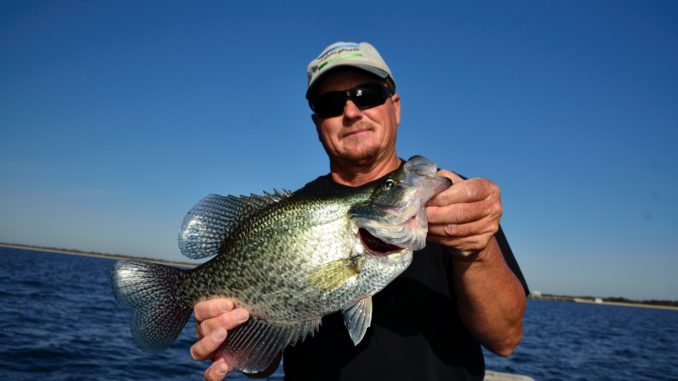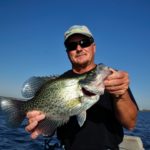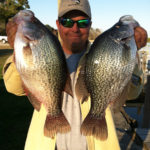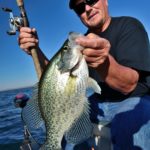
Jigs and minnows fished vertically around deep brush will get you your slab-crappie fill.
As the sun cooks the waters over Berkeley County, America’s tastiest freshwater favorite continues to offer anglers an outlet for their prized flesh. Millions of the Santee Cooper lakes’ black crappie have left their shallow-water love nests to frolic again in their normal, deep stomping grounds.
For some, crappie fishing is over when the last speckled bandit departs the shallow waters around the cypress trees and lily pads. But make no mistake, the post-spawn crappie season in Santee Cooper country is epic — and in more ways than one.
The current state of Santee Cooper’s crappie fishery could not offer anglers any better place on the planet to consistently catch trophy-sized fish. Guide Kevin Davis of Blacks Camp has noticed a turnaround in the fishery over the past few years.
“They’re back with a vengeance with some of the biggest crappie we have ever seen,” Davis said. “You will not catch any bigger crappie in South Carolina — and probably not anywhere else in the United States.”
Whether as a response from the drastic fluctuation in lake levels, changes in predator/prey relationships or just a natural swing in the freshwater ecosystem, Lake Moultrie and Lake Marion are producing exceptional catches of trophy-sized crappie. And the post-spawn season is one of the best opportunities for anglers to hone in on these speckled delicacies in deep water.
Since black crappie spawn in shallow water, they are often mistaken as preferring lake edges and shallow, stump-filled flats throughout the year.
Nothing could be further from the truth.
Indeed, black crappie slide into the shallow-water jungles when water temperatures rise enough to support fertilization. Typically, males move into shallow water to fan out the beds as the water temperature reaches 50 degrees, but the females will not deposit their eggs until it reaches and exceeds 58 degrees. Fishermen preferring the shallow-water approach begin catching crappie early in the season, and crappie will trade off between shallow and deep until all of the females have spawned.
According to guide Steve English of Cross, crappie will spawn as early as February on Lake Moultrie, and the spawn will extend into the first couple of weeks of April on Lake Marion. He said the water temperature will have a dramatic effect on crappie movements throughout the year.
“Water temperature controls the movement of crappie during the spawning season and throughout the year,” English said, “and the lower lake (Moultrie) generally warms quicker than the upper lake.”
Not all crappie follow the same regiment, prolonging the spawn season through several months. Regardless, fisherman won’t sink a minnow or dangle a jig any shallower than 15 to 25 feet after May 1 — if they want to catch fish.
After spawning, crappie move back to deep water, hitting moderate depths first and then continuing to their summer holding range when the waters heat significantly.
“We target post-spawn crappie right off the beds in seven to 12 feet first, and then to the 20- to 25-foot places shortly afterwards for the rest of the year,” English said. “Crappie are on the move most of the time, and we hit a few places at different depths until we find a group of fish stacked on structure.”
With the exception of the spawning season, English relies heavily on his depth finder and GPS to steer his boat towards concentrations of fish.
“Deep-water crappie associate with structure, whether it is brush piles, stumps or tree tops,” English said. “Baitfish are drawn for protection to the structure that attracts crappie and other predator fish. If you can mark a few stumps in deep water, a school of crappie will be using it.”
English and Davis fish mostly brush piles after the spawn. The conglomeration of small trees and limbs tied together and sunk to the bottom provide ideal conditions for crappie in deep-water environments. While a few select brush piles seem to hold more fish than others, Davis has the best luck with structure placed or occurring near a significant lake feature.
“We build them in mouths of major creeks, sides of island or on the edges of former swamp runs, but they are all in 25 foot of water,” he said. “They love getting by vertical cover.”
Typically, the best structure will extend off the bottom one-third of the distance to the surface.
“If we have 22 feet of water, I like the brush eight feet off the bottom,” Davis said.
While there are many brush piles sunk all over the two lakes by recreational fishermen, both lakes were formerly forested swamplands, and much of the bottoms are covered in remnant woody debris. A good bottom-sounder with the new down-scanning imaging technology will reveal these deep-water crappie dens with little effort.
The S.C. Department of Natural Resources maintains 13 fish attractors on Marion and 19 more on Moultrie — mostly brush piles. These fish attractors are known by locals to hold large crappie populations outside of the spawning season. According to English, the three brush piles lined up in Angel’s Cove (Nos. 5, 6, and 7) are some of the best.
“The three DNR brush piles near Angel’s Landing (on Moultrie) were placed between the old trade canal and the creek channel,” he said. “Over the years, Angel’s Cove has produced some of the biggest crappie ever caught on this lake system.”
After the sounder screen lights up with fish around brush piles, catching the speckled fish can come easily if the right baits and lures are presented in the right places. After locating the fish, Davis pulls off just enough line to place his lure right in front of the fish’s noses.
“Try to put the baits right at the top of the brush. The fish on top of the piles are your feeding fish,” he said. “If you get those excited enough to bite, the ones in the middle of the pile or at the bottom of the pile will come up to get a piece of the action.”
With the exception of the spawning grounds — when an insect or worm makes it to their stomach — crappie eat almost entirely small fish or minnows. While not much of a surprise, the best baits are either small crappie jigs or live minnows. Depending on the day, Davis and English will rotate back and between the two options.
“Some days they bite the jig better, and other days the minnows seem to be a necessity,” Davis said. “The pink Tuffy minnows, or what some people call rosy red minnows, stay alive longer and work real hard for you.”
English prefers jigs over minnows on most days. He will use a variety of different colors and the lightest size jighead he can get away with, depending on the wind intensity.
While the spawn and the move to the shallows turns on fishermen as much as it does fish, the productive post-spawn on Santee Cooper can easily convert crappie fishermen to this alternative lifestyle. With May being the first full month after the spawn, crappie will be hungry and ready to feast on any available forage fish that come their way. With a little patience and a high definition fish-finder, anglers should have plenty of action this month with small minnows and jigs in deep water.
DESTINATION INFORMATION
HOW TO GET THERE/WHEN TO GO — The Santee Cooper lakes, Marion and Moultrie, are northwest of Charleston and south of Manning between I-26, US 52 and I-95. Numerous boat ramps are available around the perimeter of the lakes. Crappie usually complete their spawn by mid-April, then retreat to deeper water — eight to 12 feet through early May, then 18 to 28 feet the rest of the year. The best days are bright and sunny, but with a small chop on the water’s surface. Using your electronics, locate brush piles along the edges of creek channels, on points and around creek mouths. SCDNR has numerous brush piles sunk in deep water.
TACKLE/TECHNIQUES — Fish vertically above and around deep structure with minnows and mini-jigs. Minnows should be impaled on a No. 4 gold Aberdeen hook, weighed down with a No. 1 split shot 8 inches up the line. For jigs, experiment with a wide variety of colors and sizes. White, pink, red, blue, green, chartreuse and different combinations have produced plenty of fish. Use the lightest jig possible, normally 1/32-ounce on the light end and 1/8-ounce on the heavy side. Try to fish just above the structure and set the hook on the slightest tap. Best rods are 6- to 8-foot baitcasting or spinning with fast-action tips and small reels spooled with 6-pound test. A long-handled landing net is essential, because the Santee Cooper lakes are filled with 2- and 3-pound slabs.
GUIDES/FISHING INFO — Steve English, 843-729-4044 or www.fishingwithsteveenglish.com; Kevin Davis, Black’s Camp, 843-753-2231 or www.blackscamp.com.
ACCOMMODATIONS — Black’s Camp, 843-753-2231 or www.blackscamp.com; Santee Cooper Country, 843-854-2131 or www.santeecoopercountry.com; S.C. Association of Visitors Bureaus (www.discoversouthcarolina.com).
MAPS — DeLorme’s South Carolina Atlas & Gazetteer, 207-846-7000 or www.delorme.com; Atlantic Mapping, Inc. www.fishingGPSmaps.com; Kingfisher Maps, 800-326-0257 or www.kfmaps.com; Fishing Hot Spots, 800-ALL-MAPS or www.fishinghotspots.com; SCDNR fish attractors, http://www.dnr.sc.gov/fish/fishattract/fishattr.html.








Be the first to comment